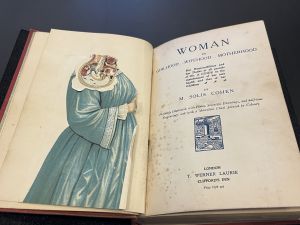Woman in girlhood-wifehood-motherhood
Introduction and Overview:

Woman in Girlhood-Wifehood-Motherhood: her responsibilities and her duties at all periods of life -- a guide in the maintenance of her own health and that of her children was written in 1908 by Myer Solis-Cohen and published in London, England by T. Werner Laurie. It was in the 20th century when this book was published that the field of obstetrics had begun to gain prominence in the medical curriculum spurred by the introduction of new technological innovations in childbirth and a heightened focus on antenatal care.[1] This book aims to inform both medical professionals and the general populace about female health and well-being.
While this book’s previous ownership remains unknown, it now resides in the Kislak Center for Special Collections at the University of Pennsylvania Van Pelt-Dietrich Library Center. The book was obtained with the assistance of the Julia B. Leisenring Book Fund which was established in 1977.
Book Significance:
About the Author:

Dr. Myer Solis-Cohen was a distinguished internist with a specialty in pediatrics. [2] He graduated from the University of Pennsylvania in 1897 and attended the University of Pennsylvania Perelman School of Medicine from which he graduated in 1900.[2] His contributions to the field of medicine reach far beyond his clinical practice as he was deeply involved in the medical affairs at the University of Pennsylvania and the surrounding Philadelphia area. He also served as a former lecturer in Medical Jurisprudence and Toxicology at the Women’s Medical College, the first medical college to educate female physicians.[2] He has authored three books along with over one hundred medical articles, one of which being Woman in Girlhood-Wifehood-Motherhood, which served as an educational tool to inform lectures on women’s health at the Hospital of the University of Pennsylvania, the Philadelphia General Hospital, and the Jewish Hospital. [2] His dedication to serving as an educator in medicine and a medical provider to the greater Philadelphia area is reflected in his distributed publications and various leadership positions in the medical community.
Historical Context:
Woman in Girlhood-Wifehood-Motherhood was written during the advent of obstetric and gynecological innovations. While early medical practices had emphasized the supportive role of the physician and midwife during delivery, with the mother at the forefront, more modern practices have altered the narrative of childbirth to be a “partnership” between both the mother and the medical practitioner.[3] This revised conceptualization of childbirth and the expanded role of the physician gained traction during the early to mid-20th century when hospitalization and antenatal intervention became more common practices for pregnant and birthing mothers.[3]This idea reduces the mother to a substitutable vessel, whose behaviors have the potential to be conflicting with the fetus she carries.[3] Woman in Girlhood-Wifehood-Motherhood intends to inform providers about the practices women should carry out during the different stages of pregnancy and womanhood, from menstruation to menopause. The book also includes instructions on conventional child-rearing practices in the early twentieth century and the role of women in marriage. While this book contains useful medical information, cultural interpretations of female physiological phenomena, and societal gender norms remain peppered throughout the literature. One notable example includes information regarding specific acceptable clothing options for women, many of which uphold early 20th-century societal gender expectations, including medically inaccurate information about the impact of donning specific colors on a woman's health and well-being. Other examples focus on the mother's role in childrearing as opposed to the husband's more absent contribution as the family's provider. Therefore, it is important to note that although books such as these have helped to pioneer the way for innovations in obstetrics and gynecology, the historical context in which these works were written and produced must also be considered.
Physical Features:
Flap Anatomy and Illustrations:

In the second half of the sixteenth century, the birth of different modes of scientific investigation following the creation of new technological innovations such as the microscope shifted the way we seek to understand the world along with its physical and natural phenomena. As a result, at the height of the scientific revolution, illustrated and interactive “movable” scientific books became increasingly valuable in understanding new knowledge. [4] These books often included mechanical or paratextual features intended to engage with the reader. [4] Flaps were developed and used in a multitude of anatomical books and were designed to conceal one or more underlying images. [4] Through this, the book was transformed into a vehicle for knowledge and a space for self-instruction and experimentation.
Woman in girlhood-wifehood-motherhood contains a remarkable flap anatomy following several flyleaves at the beginning of the book. The illustrations are printed and colored while each of the flaps are neatly glued on top of one another. The left edge of the flap anatomy, which is securely pasted down onto the page by glue is slightly uneven, leaving the impression that the flap anatomy may have been assembled and glued into the book by hand. This mode of depicting anatomy was a useful tool at the time as it allowed for readers to peer into the human body where the technology or tools to conduct dissections for learning may not have been readily available. Overall, this flap anatomy provides an insightful visual context for many of the various body parts and organs mentioned throughout the book. An “explanation of the manikin chart” is also available following the preface of the book. Each part of the flap anatomy is labeled by a number, which corresponds to a number on the “explanation of the manikin chart” page followed by a more detailed description of what the piece represents. Other visual pieces are used to supplement the text throughout the book, several of which are depicted in color.
Substrate, Platform, and Format:
The book is medium-sized, spanning about 6 by 9 inches, and is a deep red color. An impression stamp of the publisher’s logo can be found on the front cover. The book also has a front and back, pale green pastedown, and a free endpaper of the same coloration. The pages are cream-colored and made of paper. Additionally, the book block is gilded with the very top edge of each page coated with a thin layer of gold while the other sides are not. The gilded book block may have not served solely an aesthetic purpose but a practical one as well, as gilding may have prevented the edges of pages from becoming damaged or collecting dust.

This book object is a codex with a folio bibliographical format. The cover of the book, which appears to be made of cardboard, along with the spine exhibits some damage, which may be evidence of some wear and tear. The publisher and author are all listed on the spine of the book.
Binding and Structure:
The book’s binding history remains for the most part unknown, and it cannot be confirmed whether or not the binding itself is contemporaneous with the date of publication. However, it appears that the book was bound with a clear glue that has slightly yellowed over time. Additionally, while the joint of the book has undergone some minor damage, the binding itself remains fully intact and the book is in relatively good condition considering its age.
Paratexts & Illustrations:
A preface is written by the author, Myer Solis-Cohen and the address at which the preface was written is also displayed. The address is listed as 4110 Parkside Avenue, Philadelphia, not far from the Hospital of the University of Pennsylvania where this book was used to inform lecture material. The author also states in the preface that this book was not only provided as a resource to the University of Pennsylvania but was also intended to be used at surrounding medical institutions including the Philadelphia General Hospital and the Jewish Hospital.

Readership and Use:
Marginalia and Annotations, along with other marks:
The book is void of any marks or annotations from previous owners. There are no asemantic marks on the book, the lack of which may further the idea that the book may have been to be used as a reference text than to be read chronologically. Since smaller pieces of information were pulled from the book, at any given time it may have been more unlikely for readers to spend time annotating or marking up the text.
The book contains a table of contents which is organized into three distinct parts, each part – Parts I, II, and III – contains chapters that are labeled by title and Roman numeral. The book also contains an index and a glossary highlighting important terms used throughout the book. The extremely organized formatting of the book suggests that this book may have been intended as a resource for medical practitioners, lecturers, and the general public to refer to when seeking specific medical information. Rather than intending to be read chronologically, the extremely structured layout of the book transforms it into a repository of information, a database that can be used to facilitate the efficient retrieval and use of specific information. The table of contents also contains a short description of each chapter following its title along with the page number where the chapter starts. This makes the book easily navigable and allows for viewers to pull specific information from the book in an efficient manner.
Concluding Remarks
Advancements in Obstetrics and Gynecology Literature
During the early 19th century, high maternal mortality rates affected women of all socioeconomic classes. [1] This coupled with the lack of research conducted in the field of obstetrics and gynecology at the time made childbirth a dangerous task. Across maternity hospitals in parts of Europe such as in England and Wales, two to eight pregnancies out of every one hundred would result in the death of a pregnant mother.[1] Around this time, “midwifery” became a compulsory field of study for medical students in Scotland and England. [1] As a result, increasing amounts of publications regarding new practices in the field of women’s reproductive health were produced and circulated in parts of Europe.[1] These practices often aimed to reduce the risk associated with puerperal fever, a postpartum infection, and were adopted throughout the majority of British and American hospitals.[1] The far-reaching influence of these early works serves as a testament to the importance of the widespread dissemination of scientific literature, especially in the field of reproductive health. Works such as Woman in girlhood-wifehood-motherhood: her responsibilities and her duties at all periods of life: a guide in the maintenance of her own health and that of her children by Myer Solis-Cohen could be consumed by both medical professionals and the general populace alike. Therefore, they performed as an invaluable tool during an age when women were far less likely to receive proper gynecological care or have access to the proper resources to educate themselves about how to maintain their physical and mental well-being. While these publications are not perfect, they are an important part of the emergence of reproductive care practices and have played an integral role in shaping the way we treat women’s health today.
References
- ↑ 1.0 1.1 1.2 1.3 1.4 1.5 Drife, J. “The start of life: A history of obstetrics.” Postgraduate Medical Journal, vol. 78, no. 919, 1 May 2002, pp. 311–315, https://doi.org/10.1136/pmj.78.919.311.
- ↑ 2.0 2.1 2.2 2.3 "Dr. Myer Solis-Cohen, Physician, Educator Was 82." The Jewish Exponent (1887-1990), Jan 15, 1960, pp. 59. ProQuest, https://proxy.library.upenn.edu/login?url=https://www.proquest.com/historical-newspapers/dr-myer-solis-cohen-physician-educator-was-82/docview/2796026884/se-2.
- ↑ 3.0 3.1 3.2 Warsh, Cheryl Krasnick. Prescribed Norms: Women and Health in Canada and the United States since 1800, Toronto: University of Toronto Press, 2010. https://doi-org.proxy.library.upenn.edu/10.3138/9781442686557
- ↑ 4.0 4.1 4.2 Crupi, Gianfranco. “Volvelles of Knowledge. Origin and Development of an Instrument of Scientific Imagination (13th-17th Centuries).” JLIS.It, 7 Jan. 2019, jlis.fupress.net/index.php/jlis/article/view/73.